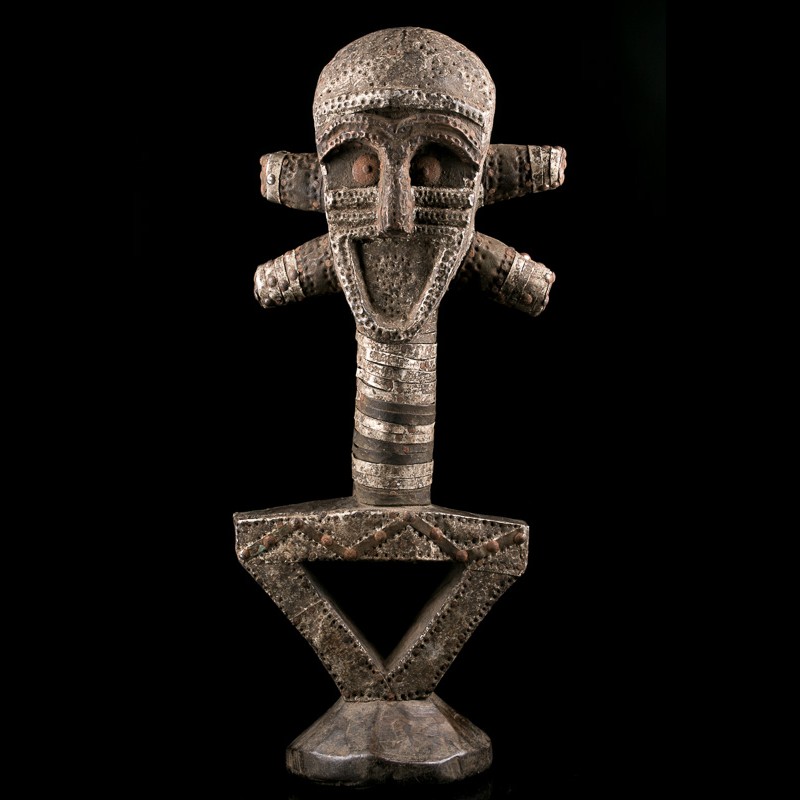














A wooden figure displaying beautiful abstract form enhanced by metal casing to the surface, along with metal bands that are nailed into place enhancing various features. The head is elongated with the forehead marked by a series of punched holes forming arch shapes. The eyebrows are formed from seperate bands that extend down to the small nose. The eyes are made from circular metal discs with red pigment and are set back into the deeply recessed sockets. Two bands to the cheeks possibly represent scarification marks. The mouth is formed as an elongated opening. To the sides of the head are two tubular protuberances to either side with bands of metal to the ends. The neck is long with various bands wrapped round. The simple waist is flat to the top with a wave pattern of separately attached metal strips. The legs sharply turn down to meet at the bottom forming an inverted triangle. Thebase is an oval sheathed in metal.
These ancestor figures form some of the most recognisable statues from Africa, that have become sought after collectors pieces, and which have been the favourite of many of the well known artists of the Modernist movement, such as Picasso. Indeed the highly abstract forms of these reliquaries had a profound impact on the art of many of these Western artists. These figures represent the most influential ancestors of the Kota people and were venerated by the extended families until as recently as the middle of the 2oth century. The ancestor cult is known as bwiti among the Kota and the responsibility for such pieces falls on the elders of the community who commission them to be made by specialist craftsmen. The figures are attached to the top of a basket which contained relics of the ancestors; the figures acted as the public image of the ancestor venerated and a focus for ritual. The veneration of the ancestors was done in the hope that they would intercede in times of crisis ensuring success in matters ranging from fertility and health to hunting and trading. They also played a key role in initiation ceremonies where the transfer of knowledge played a crucial role.
Data sheet

A wooden figure displaying beautiful abstract form enhanced by metal casing to the surface, along with metal bands that are nailed into place enhancing various features. The head is elongated with the forehead marked by a series of punched holes forming arch shapes. The eyebrows are formed from seperate bands that extend down to the small nose. The eyes are made from circular metal discs with red pigment and are set back into the deeply recessed sockets. Two bands to the cheeks possibly represent scarification marks. The mouth is formed as an elongated opening. To the sides of the head are two tubular protuberances to either side with bands of metal to the ends. The neck is long with various bands wrapped round. The simple waist is flat to the top with a wave pattern of separately attached metal strips. The legs sharply turn down to meet at the bottom forming an inverted triangle. Thebase is an oval sheathed in metal.
These ancestor figures form some of the most recognisable statues from Africa, that have become sought after collectors pieces, and which have been the favourite of many of the well known artists of the Modernist movement, such as Picasso. Indeed the highly abstract forms of these reliquaries had a profound impact on the art of many of these Western artists. These figures represent the most influential ancestors of the Kota people and were venerated by the extended families until as recently as the middle of the 2oth century. The ancestor cult is known as bwiti among the Kota and the responsibility for such pieces falls on the elders of the community who commission them to be made by specialist craftsmen. The figures are attached to the top of a basket which contained relics of the ancestors; the figures acted as the public image of the ancestor venerated and a focus for ritual. The veneration of the ancestors was done in the hope that they would intercede in times of crisis ensuring success in matters ranging from fertility and health to hunting and trading. They also played a key role in initiation ceremonies where the transfer of knowledge played a crucial role.